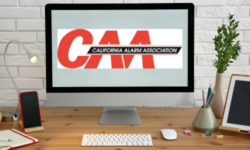How Audio Can Improve Your Emergency Evacuation Plan
Security and audio integrators need to work together to ensure people know exactly what to do in an emergency evacuation.

Last April, the Army’s Golden Knights performed a pregame performance at a Washington Nationals baseball game.
However, it appears that the performance wasn’t communicated (or wasn’t communicated properly) with the U.S. Capitol Police, which viewed it as a possible security threat to the U.S. Capitol and evacuated the Capitol out of caution.
“The Golden Knights parachuted into the stadium, blocks from the Capitol, as part of Military Appreciation Night,” said a news report. It added: “There was a miscommunication between Capitol Police and the organizers of the pregame events.”
According to the news report, the Capitol Police is made aware of hundreds of authorized flights in the “restricted airspace” every week, and that the lack of coordination was “extremely unusual.”
“As soon as it was determined that we were not given advanced notice of an approved flight, our officers followed USCP policies and procedures and immediately led everyone safely out of the Congressional buildings,” the agency said.
The Emergency Evacuation
That type of emergency situation – where hundreds or even thousands of people need to be evacuated – happens on a regular basis.
What are some common types of emergencies that may require an evacuation?
- Natural Disasters: floods, hurricanes, tornadoes, earthquakes
- Release of Hazardous Material: chemical spills, toxic gas releases
- Fires and Explosions: Fires and gas leak explosions
- Violent Acts: active shooter incidents, bomb threats, terrorist events, violent protests
In an emergency evacuation, with flashing lights, sounding alarms, and panic, people’s instinct likely is to leave a building or facility as quickly as possible. Some individuals, however, may panic because they are unsure about what to do and they may freeze and not move.
That’s milling and it’s not good, according to Dr. Larry Barton, a threat management, workplace violence, and crisis management professional.
During an emergency, he says that some “people will experience such emotional trauma that they literally freeze – they psychologically and physically shut down. The event is so out of the norm for them in their day-to-day reliance upon norms that they are unable to function.”
He says that “milling is most pronounced when existing organizations and institutional procedures are inadequate or inappropriate for the situation at hand.”
Therefore, during an evacuation, the clear progression of steps can calm nerves and eliminate confusion and get people out quickly and safely. Alerts, warnings, and announcements must be accurate, delivered very quickly, and be easily heard and understood.
Does your facility’s evacuation plan allow everyone in the facility – no matter who they are – an employee, a visitor, or a vendor – and no matter what room or area they are in – to clearly hear evacuation instructions?
The Plan
There are many elements to a facility’s evacuation plan.
Each facility’s plan will differ, but according to the Occupational Safety and Health Administration , those elements should include:
- clear chain of command (based on role/responsibility)
- contact details of local emergency services and authorities
- emergency alert system for employees and visitors
- primary method of communication during the emergency
- specific evacuation procedures for each area in the workplace
- exit routes (including floor plans)
- locations of designated safe areas and assembly points
Audio’s Value in an Emergency Evacuation
As security professionals, you know that an emergency evacuation plan also requires training for employees, vendors, and visitors.
Yet despite the training and retraining, some individuals will be confused about signs or written instructions as to where to go, which door to use, or more. They also might be working in a secluded part of the building without windows or anyone to tell them to get out. They could also exit the wrong door or go to the wrong assembly area.
And some people will leave the building and then realize that they forgot something, such as important medication, their cellphone, or other belongings, and try to go back into the building to retrieve them.
Once everyone is out of the building, how do you keep them informed? How do you direct them where to go? Once the all-clear is given, how do you communicate that it’s okay to go back into the building?
Overall, from the beginning to the end of a building evacuation, every security team needs to convey important messages. Will those messages be heard and understood? Will your security team have a loud, clear, and highly intelligible voice in every evacuation?
That’s where audio solutions can play a critical role. Audio and voice can convey important messages that a video surveillance camera, or VMS, or access control solution cannot.
IP video allows a security team to remotely see anywhere an IP camera can be placed on a network. With a video management system, security teams can see what is happening and decide how to respond. However, with remote viewing, the event may be over by the time security physically responds. Video surveillance footage is also not interactive, as it only records the event.
Access control is an additional essential component, as well, as it can either allow or deny access, but it too, is limiting.
Integrating audio with video surveillance and access controls give security teams an interactive and proactive solution. It’s adding “ears” to your security team’s “eyes,” which are important tools to have in an evacuation.
It also has reach. Consider a facility’s perimeter that is far away from the facility itself, such as an airport, or a utility, or a warehouse. If employees need to move very far away from the facility for safety, IP speakers can be used for two-way communications.
Security teams can use video surveillance to see everyone and audio to clearly communicate with them. They can provide direction and reassurance, and the individuals can hear and talk back to them.
Only audio can keep everyone informed during an evacuation with live or pre-recorded messages. If the situation is fluid, as an evacuation can be, a security team can quickly alter the message. They can even use individual zoning technology to customize messages to specific areas, as the situation unfolds.
Once the building is evacuated, public address messages via IP speakers can keep everyone informed about how long they might need to stay out of the building, when they can go back inside, or whether they should go to another area.
During an evacuation, every facility can benefit from clear audio. For example:
- In a commercial office building or a healthcare facility, audio messages can alert individuals about which door to exit (or not to exit) and where to meet so security can ensure that everyone is out of the building.
- In large and open facilities, such as a sports venue, paging announcements via IP speakers can help staff and visitors get to where they need to be. They can help to control crowds in specific areas. They can also help to manage queues to stay or leave designated areas.
- In a train station or airport, IP speakers and audio can be used for individual zones to grouped zones to form larger areas of communication.
- In a parking garage, IP horns can direct customers on the garage’s floors or to the rooftop, near the elevators, and in the stairwells.
- In a school, ceiling speakers can communicate instructions to teachers and staff regarding when to evacuate and where to go.
- In a manufacturing facility or a warehouse, IP horns and speakers can communicate to one zone or the entire area about which exit to use and where to go.
Legal Considerations
Unfortunately, there remains a misperception around audio that sometimes delays widespread adoption – that audio recording solutions can be illegal. Audio in general isn’t illegal, nor are intercoms or mass notification solutions; it’s the recording that can become questionable. (Of course, it is always best to retain legal help if there is uncertainty).
According to the publication, Safe and Sound: a Primer on Audio and Intelligent Communications from the Security Industry Association, it’s all about letting people know that the area they are in, or entering, is under audio surveillance (and video surveillance). Transparency is key. Clearly visible and easy to read signage may be necessary.
Loud and Clear
All enterprise security systems and security teams need audio and voice communications, especially during an evacuation.
In an evacuation, only voice and audio solutions via intercom and public address solutions can effectively communicate necessary instructions as individuals exit, as they wait for further instructions, and as they enter the building again after the event is over.
Simply put, a silent security system in today’s facilities cannot allow for an effective evacuation system.
Evan Walde is the Midwest Region sales leader for Zenitel Americas.
If you enjoyed this article and want to receive more valuable industry content like this, click here to sign up for our FREE digital newsletters!

Security Is Our Business, Too
For professionals who recommend, buy and install all types of electronic security equipment, a free subscription to Commercial Integrator + Security Sales & Integration is like having a consultant on call. You’ll find an ideal balance of technology and business coverage, with installation tips and techniques for products and updates on how to add to your bottom line.
A FREE subscription to the top resource for security and integration industry will prove to be invaluable.







